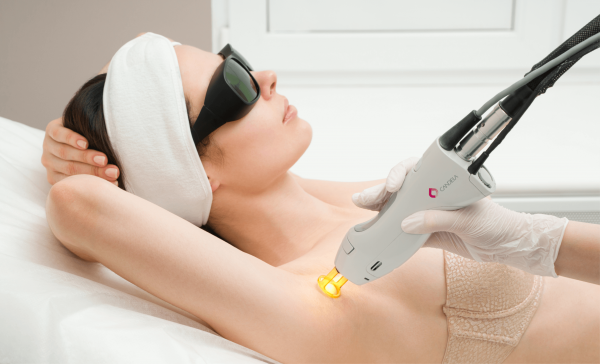Laser hair removal is the latest cosmetic procedure designed for noninvasive hair removal from the face and body. It requires multiple sessions to achieve maximum results. Probably the most common question we’re asked is, “how long does laser hair removal last?”.
After all, we’re all searching for a permanent, painless, and effective hair removal technique. The answer is – it depends. Some individuals see permanent or near-permanent reductions in hair growth, while others may experience gradual hair regrowth over time.
We can’t make any promises – it’s out of our hands.
To better understand the question, “how long does laser hair removal last?” we explore the science behind hair growth below. We’ll explain the key factors that determine the effectiveness of this innovative new treatment.
How long does laser hair removal last?
In order to answer this question, we need to understand what’s going on inside the hair follicle. That means the stages of hair growth
Hair growth stages
Your hair follicles go through four growth stages:
- Anagen (Growing Phase). Lasts around 3 to 5 years, and up to seven years or more in some people. Most hair follicles are in a growing phase at any one time.
- Catagen (Transition Phase). As the hair follicle stops growing, it goes through the catagen phase. Lasting around ten days, the hair follicle shrinks, and growth slows.
- Telogen (Resting Phase). Lasts around three months. No hair will grow during this time, but the existing hair will remain in place. New hairs may begin to form.
- Exogen (Shedding Phase). The hair in the follicle will be shed, making room for new hair to begin to grow. The exogen phase lasts around 2 to 5 months.
Your body hair isn’t all in sync; they’ll be hair follicles in every stage of the cycle at any one time.
Why do you see hair regrowth?
Because some hairs are dormant during any session (phases 2 to 3), it’s hard to eliminate all the hairs in a single session. And laser hair removal isn’t 100% effective in killing every hair follicle.
Laser hair removal uses light to send heat down the dark hair, heating up the hair follicle below the skin’s surface. With enough heat, the hair follicle is irreparably damaged, preventing future regrowth.
However, after each session, some hair follicles will repair themselves. In contrast, others will exit the exogen phase and go back into the anagen phase – meaning new growth.
That’s why it takes multiple sessions to see the best effects.
Regrowth on the face and body
Your body hair typically regrows at a slower rate than on your scalp or face. Indeed, it’s part of why our body hair is so much sparser. After the treatment is completed, it can take years for regrowth to occur on your body, and what does grow back should be sparse and fine.
In contrast, regrowth is substantially more common on your face. Best results indicate no growth for ten years or more. But most people will require some touchup treatments to maintain a totally hair-free appearance.
No procedure is 100% effective. But with its ease of use and general effectiveness, laser hair removal remains one of the best permanent or semi-permanent hair removal techniques available.
How do hair and skin color affect laser hair removal
Because laser hair removal relies on hair pigmentation, it works best with dark, coarser hair. However, our most advanced machines are substantially more powerful than older models. Using these devices, we can treat some lighter hair types.
We’ll still struggle to see substantial effectiveness against blond, white, or gray hair, however. Such hair colors should consider electrolysis for permanent hair removal.
Hair color or skin types won’t affect the regrowth rate.
Do certain conditions increase the rate of regrowth?
Yes. Hair growth is controlled, in part, by hormonal fluctuations (androgens like dehydroepiandrosterone (DHEA) and testosterone – yes, even in women).
Higher levels of these hormones can lead to more substantial hair growth in certain conditions, including in areas previously treated by laser hair removal.
For example, estrogen levels drop (and androgen levels increase) in menopausal women. In some cases, it can cause regrowth on the upper lip, chin, neck, and sideburn areas of the face. Hair regrowth is also possible elsewhere on the body. However, you can still expect the regrowth to be sparser and fine.
In addition, people with polycystic ovarian syndrome (PCOS) can see hormonal fluctuations, potentially triggering hair regrowth. Balancing hormones with medication or diet will prevent this problem.
Can further sessions reduce regrowth?
Yes. You’ll generally receive a short course of around four sessions to begin. Afterwards, you’ll see a substantial reduction in hair growth for several months. You’ll then go for touchup sessions to continue reducing regrowth going forward – often on a semiannual basis.
Typically, after more than 12 sessions, hair growth should be minimal to non-existent. Only in rare cases do we expect to see further growth.
But, if growth does occur, laser hair removal is 100% safe for continued use. So, it’s just as simple as booking another session.
Laser hair removal is effective, lasting, and safe
You can expect laser hair removal to last several years after an entire course of sessions and a few touchups. Because some hair follicles remain dormant at any one time, a single session is never 100% effective. But with repeated laser hair removal sessions, thousands of people report lasting and permanent results.
Just remember, laser hair therapy isn’t suitable for certain hair colors. And specific conditions can increase your chances of regrowth.
For an alternative permanent hair removal technique, consider electrolysis. Contact us today for further details about any of our hair removal techniques.


